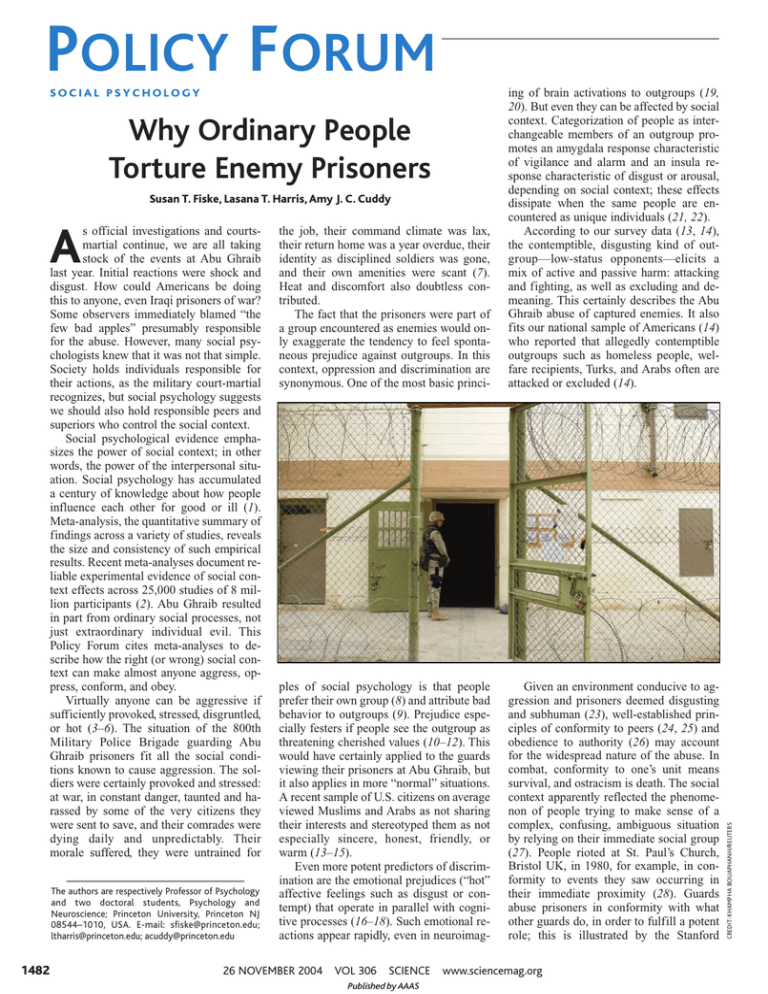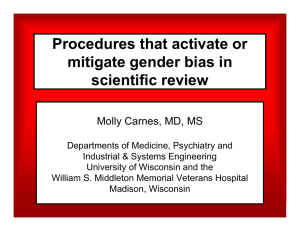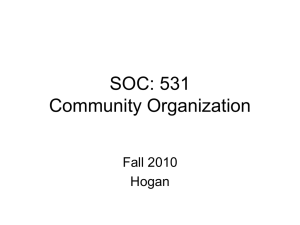A
advertisement

the job, their command climate was lax, their return home was a year overdue, their identity as disciplined soldiers was gone, and their own amenities were scant (7). Heat and discomfort also doubtless contributed. The fact that the prisoners were part of a group encountered as enemies would only exaggerate the tendency to feel spontaneous prejudice against outgroups. In this context, oppression and discrimination are synonymous. One of the most basic princi- ing of brain activations to outgroups (19, 20). But even they can be affected by social context. Categorization of people as interchangeable members of an outgroup promotes an amygdala response characteristic of vigilance and alarm and an insula response characteristic of disgust or arousal, depending on social context; these effects dissipate when the same people are encountered as unique individuals (21, 22). According to our survey data (13, 14), the contemptible, disgusting kind of outgroup—low-status opponents—elicits a mix of active and passive harm: attacking and fighting, as well as excluding and demeaning. This certainly describes the Abu Ghraib abuse of captured enemies. It also fits our national sample of Americans (14) who reported that allegedly contemptible outgroups such as homeless people, welfare recipients, Turks, and Arabs often are attacked or excluded (14). ples of social psychology is that people prefer their own group (8) and attribute bad behavior to outgroups (9). Prejudice especially festers if people see the outgroup as threatening cherished values (10–12). This would have certainly applied to the guards viewing their prisoners at Abu Ghraib, but it also applies in more “normal” situations. A recent sample of U.S. citizens on average viewed Muslims and Arabs as not sharing their interests and stereotyped them as not especially sincere, honest, friendly, or warm (13–15). Even more potent predictors of discrimination are the emotional prejudices (“hot” affective feelings such as disgust or contempt) that operate in parallel with cognitive processes (16–18). Such emotional reactions appear rapidly, even in neuroimag- Given an environment conducive to aggression and prisoners deemed disgusting and subhuman (23), well-established principles of conformity to peers (24, 25) and obedience to authority (26) may account for the widespread nature of the abuse. In combat, conformity to one’s unit means survival, and ostracism is death. The social context apparently reflected the phenomenon of people trying to make sense of a complex, confusing, ambiguous situation by relying on their immediate social group (27). People rioted at St. Paul’s Church, Bristol UK, in 1980, for example, in conformity to events they saw occurring in their immediate proximity (28). Guards abuse prisoners in conformity with what other guards do, in order to fulfill a potent role; this is illustrated by the Stanford SOCIAL PSYCHOLOGY Why Ordinary People Torture Enemy Prisoners Susan T. Fiske, Lasana T. Harris, Amy J. C. Cuddy s official investigations and courtsmartial continue, we are all taking stock of the events at Abu Ghraib last year. Initial reactions were shock and disgust. How could Americans be doing this to anyone, even Iraqi prisoners of war? Some observers immediately blamed “the few bad apples” presumably responsible for the abuse. However, many social psychologists knew that it was not that simple. Society holds individuals responsible for their actions, as the military court-martial recognizes, but social psychology suggests we should also hold responsible peers and superiors who control the social context. Social psychological evidence emphasizes the power of social context; in other words, the power of the interpersonal situation. Social psychology has accumulated a century of knowledge about how people influence each other for good or ill (1). Meta-analysis, the quantitative summary of findings across a variety of studies, reveals the size and consistency of such empirical results. Recent meta-analyses document reliable experimental evidence of social context effects across 25,000 studies of 8 million participants (2). Abu Ghraib resulted in part from ordinary social processes, not just extraordinary individual evil. This Policy Forum cites meta-analyses to describe how the right (or wrong) social context can make almost anyone aggress, oppress, conform, and obey. Virtually anyone can be aggressive if sufficiently provoked, stressed, disgruntled, or hot (3–6). The situation of the 800th Military Police Brigade guarding Abu Ghraib prisoners fit all the social conditions known to cause aggression. The soldiers were certainly provoked and stressed: at war, in constant danger, taunted and harassed by some of the very citizens they were sent to save, and their comrades were dying daily and unpredictably. Their morale suffered, they were untrained for A The authors are respectively Professor of Psychology and two doctoral students, Psychology and Neuroscience; Princeton University, Princeton NJ 08544–1010, USA. E-mail: sfiske@princeton.edu; ltharris@princeton.edu; acuddy@princeton.edu 1482 26 NOVEMBER 2004 VOL 306 SCIENCE Published by AAAS www.sciencemag.org CREDIT: KHAMPHA BOUAPHANH/REUTERS POLICY FORUM POLICY FORUM Prison Study, in which ordinary college students, randomly assigned to be full-time guards and prisoners in a temporary prison, nevertheless behaved respectively as abusers and victims (29). Social psychology shows that, whatever their own good or bad choices, most people believe that others would do whatever they personally chose to do, a phenomenon termed false consensus (30, 31). Conformity to the perceived reactions of one’s peers can be defined as good or bad, depending on how well the local norms fit those of larger society. As every graduate of introductory psychology should know from the Milgram studies (32), ordinary people can engage in incredibly destructive behavior if so ordered by legitimate authority. In those studies, participants acting as teachers frequently followed an experimenter’s orders to punish a supposed learner (actually a confederate) with electric shock, all the way to administering lethal levels. Obedience to authority sustains every culture (33). Firefighters heroically rushing into the flaming World Trade Center were partly obeying their superiors, partly conforming to extraordinary group loyalty, and partly showing incredibly brave self-sacrifice. But obedience and conformity also motivated the terrorist hijackers and the Abu Ghraib guards, however much one might abhor their (vastly different) actions. Social conformity and obedience themselves are neutral, but their consequences can be heroic or evil. Torture is partly a crime of socialized obedience (34). Subordinates not only do what they are ordered to do, but what they think their superiors would order them to do, given their understanding of the authority’s overall goals. For example, lynching represented ordinary people going beyond the law to enact their view of the community’s will. Social influence starts with small, apparently trivial actions (in this case, insulting epithets), followed by more serious actions (humiliation and abuse) (35–37), as novices overcome their hesitancy and learn by doing (38). The actions are always intentional, although the perpetrator may not be aware that those actions constitute evil. In fact, perpetrators may see themselves as doing a great service by punishing and or eliminating a group that they perceive as deserving ill treatment (39). In short, ordinary individuals under the influence of complex social forces may commit evil acts (40). Such actions are human behaviors that can and should be studied scientifically (41, 42). We need to understand more about the contexts that will promote aggression. We also need to understand the basis for exceptions—why, in the face of these social contexts, not all individuals succumb (43). Thus, although lay-observers may believe that explaining evil amounts to excusing it and absolving people of responsibility for their actions (44), in fact, explaining evils such as Abu Ghraib demonstrates scientific principles that could help to avert them. Even one dissenting peer can undermine conformity (24). For example, whistle-blowers not only alert the authorities but also prevent their peers from continuing in unethical behavior. Authorities can restructure situations to allow communication. For example, CEOs can either welcome or discourage a diversity of opinions. Contexts can undermine prejudice (1). Individual, extended, equal-status, constructive, cooperative contact between mutual outgroups (whether American blacks and whites in the military or American soldiers and Iraqi civilians) can improve mutual respect and even liking. It would be harder to dehumanize and abuse imprisoned Iraqis if one had friends among ordinary Iraqis. A difficult objective in wartime, but as some Iraqis work alongside their American counterparts, future abuse is less likely. The slippery slope to abuse can be avoided. The same social contexts that provoke and permit abuse can be harnessed to prevent it. To quote another report [(45), p. 94]: “All personnel who may be engaged in detention operations, from point of capture to final disposition, should participate in a professional ethics program that would equip them with a sharp moral compass for guidance in situations often riven with conflicting moral obligations.” References and Notes 1. S. T. Fiske, Social Beings (Wiley, New York, 2004). 2. F. D. Richard, C. F. Bond, J. J. Stokes-Zoota, Rev. Gen. Psychol. 7, 331 (2003). 3. B. A. Bettencourt, N. Miller, Psychol. Bull. 119, 422 (1996). 4. M. Carlson, N. Miller, Sociol. Soc. Res. 72, 155 (1988). 5. M. Carlson, A. Marcus-Newhall, N. Miller, Pers. Soc. Psychol. Bull. 15, 377 (1989). 6. C. A. Anderson, B. J. Bushman, Rev. Gen. Psychol. 1, 19 (1997). 7. A. Taguba, “Article 15-6. Investigation of the 800th Military Police Brigade,” accessed 30 June 2004 from www.npr.org/iraq/2004/prison_abuse_report.pdf 8. B. Mullen, R. Brown, C. Smith, Eur. J. Soc. Psychol. 22, 103 (1992). 9. B. Mullen, C. Johnson, Br. J. Soc. Psychol. 29, 11 (1990). 10. J. Duckitt, in Advances in Experimental Social Psychology, M. P. Zanna, Ed. (Academic Press, New York, 2001). 11. When their own mortality is salient, as in wartime, people particularly punish those from outgroups seen to threaten basic values (12). 12. S. Solomon, J. Greenberg, T. Pyszczynski, Curr. Dir. Psychol. Sci. 9, 200 (2000). 13. S. T. Fiske, A. J. Cuddy, P. Glick, J. Xu, J. Person. Soc. Psychol. 82, 878 (2002). 14. A. J. Cuddy, S. T. Fiske, P. Glick, “The BIAS map: Behaviors from intergroup affect and stereotypes,” unpublished manuscript (Princeton University, Princeton, NJ, 2004). www.sciencemag.org SCIENCE VOL 306 Published by AAAS 15. L. J. Heller, thesis, Princeton University, 2002. 16. H. Schütz, B. Six, Int. J. Intercult. Relat. 20, 441 (1996). 17. J. F. Dovidio et al., in Stereotypes and Stereotyping, C. N. Macrae, C. Stangor, M. Hewstone, Ed. (Guilford, New York, 1996). 18. C. A. Talaska, S. T. Fiske, S. Chaiken, “Predicting discrimination: A meta-analysis of the racial attitudes– behavior literature,” unpublished manuscript (Princeton University, Princeton, NJ, 2004). 19. A. J. Hart et al., Neuroreport 11, 2351 (2000). 20. E. A. Phelps et al., J. Cogn. Neurosci. 12, 729 (2000). 21. Neuroimaging data represent college student reactions to photographs of outgroup members. These data should not be interpreted to mean that such reactions are innate or “wired in”; they result from longterm social context (9) and vary depending on shortterm social context (46). 22. M. E. Wheeler, S. T. Fiske, Psychol. Sci., in press. 23. J. P. Leyens et al., Eur. J. Soc. Psychol. 33, 703 (2003). 24. R. Bond, P. B. Smith, Psychol. Bull. 119, 111 (1996). 25. S. Tanford, S. Penrod, Psychol. Bull. 95, 189 (1984). 26. J. Tata et al., J. Soc. Behav. Pers. 11, 739 (1996). 27. J. C. Turner, Social Influence (Brooks/Cole, Pacific Grove, CA, 1991). 28. S. D. Reicher, Eur. J. Soc. Psychol. 14, 1 (1984). 29. C. Haney, C. Banks, P. Zimbardo, Int. J. Criminol. Penol. 1, 69 (1973). 30. B. Mullen et al., J. Exp. Soc. Psychol. 21, 262 (1985). 31. B. Mullen, L. Hu, Br. J. Soc. Psychol. 27, 333 (1988). 32. S. Milgram, Obedience to Authority (Harper & Row, New York, 1974). 33. T. Blass, J. Appl. Soc. Psychol. 29, 955 (1999). 34. H. C. Kelman, in The Politics of Pain: Torturers and Their Masters, R. D. Crelinsten, A. P. Schmidt, Eds. (Univ. of Leiden, Leiden, NL, 1991). 35. A. L. Beaman et al., Pers. Soc. Psychol. Bull. 9, 181 (1983). 36. A. L. Dillard, J. E. Hunter, M. Burgoon, Hum. Commun. Res. 10, 461 (1984). 37. E. F. Fern, K. B. Monroe, R. A. Avila, J. Mark. Res. 23, 144 (1986). 38. E. Staub, Pers. Soc. Psychol. Rev. 3, 179 (1999). 39. A. Bandura, Pers. Soc. Psychol. Rev. 3, 193 (1999). 40. L. Berkowitz, Pers. Soc. Psychol. Rev. 3, 246 (1999). 41. J. M. Darley, Pers. Soc. Psychol. Rev. 3, 269 (1999). 42. A. G. Miller, Ed., The Social Psychology of Good and Evil (Guilford, New York, 2004). 43. Although social context matters more than most people think, individual personality also matters, in accord with most people’s intuitions: Social Dominance Orientation (SDO) describes a toughminded view that it is a zero-sum, dog-eat-dog world, where some groups justifiably dominate other groups. People who score low on SDO tend to join helping professions, be more tolerant, and endorse less aggression; they might be less inclined to abuse. People choosing to join hierarchical institutions such as the military tend to score high on SDO, in contrast (47 ). Right-Wing Authoritarianism (RWA) entails conforming to conventional values, submitting to authority, and aggressing as sanctioned by authority. People who score low on RWA would be less prone to abuse. (48) High SDO and RWA both predict intolerance of outgroups, social groups outside one’s own. 44. A. G. Miller, A. K. Gordon, A. M. Buddie, Pers. Soc. Psychol. Rev. 3, 254 (1999). 45. J. R. Schlesinger, H. Brown, T. K. Fowler, C. A. Homer, J. A. Blackwell Jr., Final Report of the Independent Panel to Review DoD Detention Operations, accessed 8 November 2004, from www.informationclearinghouse.info/article6785.htm 46. L. T. Harris, S. T. Fiske, unpublished data. 47. J. Sidanius, F. Pratto, Social Dominance: An Intergroup Theory of Social Hierarchy and Oppression (Cambridge Univ. Press, New York, 1999). 48. B. Altemeyer, Enemies of Freedom: Understanding Right-Wing Authoritarianism (Jossey-Bass, San Francisco, 1988). 10.1126/science.1103788 26 NOVEMBER 2004 1483





